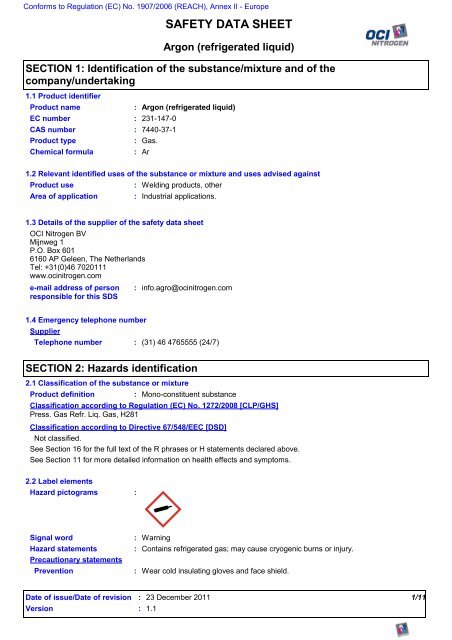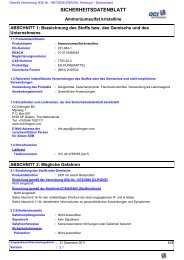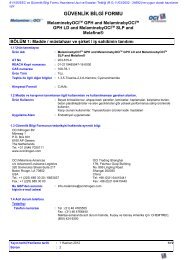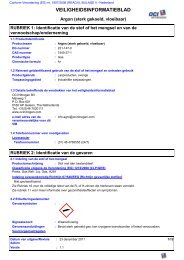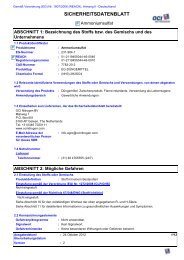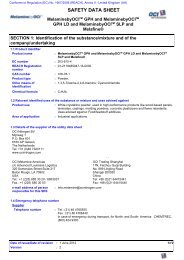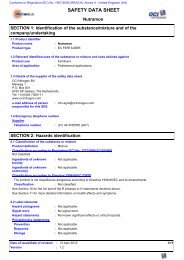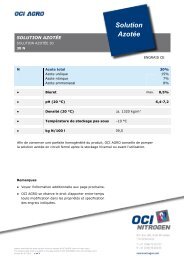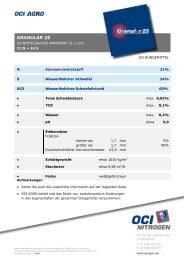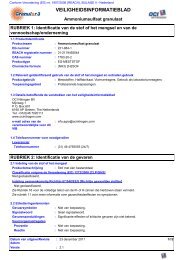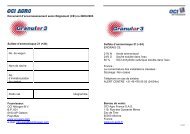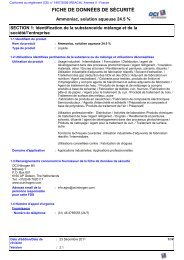Argon refrigerated liquid - Safety data sheet - Europe - OCI Nitrogen
Argon refrigerated liquid - Safety data sheet - Europe - OCI Nitrogen
Argon refrigerated liquid - Safety data sheet - Europe - OCI Nitrogen
You also want an ePaper? Increase the reach of your titles
YUMPU automatically turns print PDFs into web optimized ePapers that Google loves.
Conforms to Regulation (EC) No. 1907/2006 (REACH), Annex II - <strong>Europe</strong><br />
SECTION 1: Identification of the substance/mixture and of the<br />
company/undertaking<br />
1.1 Product identifier<br />
Product name<br />
EC number : 231-147-0<br />
CAS number : 7440-37-1<br />
Product type : Gas.<br />
Chemical formula<br />
:<br />
:<br />
<strong>Argon</strong> (<strong>refrigerated</strong> <strong>liquid</strong>)<br />
Ar<br />
SAFETY DATA SHEET<br />
<strong>Argon</strong> (<strong>refrigerated</strong> <strong>liquid</strong>)<br />
1.2 Relevant identified uses of the substance or mixture and uses advised against<br />
Product use<br />
: Welding products, other<br />
Area of application : Industrial applications.<br />
1.3 Details of the supplier of the safety <strong>data</strong> <strong>sheet</strong><br />
<strong>OCI</strong> <strong>Nitrogen</strong> BV<br />
Mijnweg 1<br />
P.O. Box 601<br />
6160 AP Geleen, The Netherlands<br />
Tel: +31(0)46 7020111<br />
www.ocinitrogen.com<br />
e-mail address of person<br />
responsible for this SDS<br />
: info.agro@ocinitrogen.com<br />
1.4 Emergency telephone number<br />
Supplier<br />
Telephone number : (31) 46 4765555 (24/7)<br />
SECTION 2: Hazards identification<br />
2.1 Classification of the substance or mixture<br />
Product definition<br />
: Mono-constituent substance<br />
Classification according to Regulation (EC) No. 1272/2008 [CLP/GHS]<br />
Press. Gas Refr. Liq. Gas, H281<br />
Classification according to Directive 67/548/EEC [DSD]<br />
Not classified.<br />
See Section 16 for the full text of the R phrases or H statements declared above.<br />
See Section 11 for more detailed information on health effects and symptoms.<br />
2.2 Label elements<br />
Hazard pictograms :<br />
Signal word :<br />
Hazard statements :<br />
Precautionary statements<br />
Prevention :<br />
Warning<br />
Contains <strong>refrigerated</strong> gas; may cause cryogenic burns or injury.<br />
Wear cold insulating gloves and face shield.<br />
Date of issue/Date of revision : 23 December 2011<br />
1/11<br />
Version : 1.1
Conforms to Regulation (EC) No. 1907/2006 (REACH), Annex II - <strong>Europe</strong><br />
<strong>Safety</strong> Data Sheet<br />
<strong>Argon</strong> (<strong>refrigerated</strong> <strong>liquid</strong>)<br />
SECTION 2: Hazards identification<br />
Response :<br />
Storage :<br />
Disposal :<br />
Thaw frosted parts with lukewarm water.<br />
Do not rub affected area.<br />
Store in a well-ventilated place.<br />
Not applicable.<br />
Supplemental label<br />
elements<br />
: Not applicable.<br />
2.3 Other hazards<br />
Substance meets the<br />
criteria for PBT according<br />
to Regulation (EC) No.<br />
1907/2006, Annex XIII<br />
Substance meets the<br />
criteria for vPvB according<br />
to Regulation (EC) No.<br />
1907/2006, Annex XIII<br />
Other hazards which do<br />
not result in classification<br />
: Not applicable.<br />
: Not applicable.<br />
: Not available.<br />
SECTION 3: Composition/information on ingredients<br />
Substance/mixture<br />
:<br />
Mono-constituent substance<br />
Product/ingredient<br />
name<br />
Identifiers % 67/548/EEC<br />
Classification<br />
Regulation (EC) No.<br />
1272/2008 [CLP]<br />
argon EC: 231-147-0<br />
CAS: 7440-37-1<br />
100 Not classified. Press. Gas Refr. Liq. Gas,<br />
H281<br />
See section 16 for the full<br />
text of the R-phrases<br />
declared above<br />
See Section 16 for the full<br />
text of the H statements<br />
declared above.<br />
There are no additional ingredients present which, within the current knowledge of the supplier, are classified and<br />
contribute to the classification of the substance and hence require reporting in this section.<br />
Occupational exposure limits, if available, are listed in Section 8.<br />
SECTION 4: First aid measures<br />
4.1 Description of first aid measures<br />
Eye contact<br />
Inhalation<br />
Skin contact<br />
Ingestion<br />
:<br />
:<br />
:<br />
:<br />
Immediately flush eyes with plenty of water, occasionally lifting the upper and lower<br />
eyelids. Check for and remove any contact lenses. Continue to rinse for at least 10<br />
minutes. Get medical attention if irritation occurs.<br />
Remove victim to fresh air and keep at rest in a position comfortable for breathing. If<br />
not breathing, if breathing is irregular or if respiratory arrest occurs, provide artificial<br />
respiration or oxygen by trained personnel. It may be dangerous to the person<br />
providing aid to give mouth-to-mouth resuscitation. Get medical attention if adverse<br />
health effects persist or are severe. If unconscious, place in recovery position and<br />
get medical attention immediately. Maintain an open airway. Loosen tight clothing<br />
such as a collar, tie, belt or waistband.<br />
Flush contaminated skin with plenty of water. Remove contaminated clothing and<br />
shoes. Get medical attention if symptoms occur. Wash clothing before reuse.<br />
Clean shoes thoroughly before reuse.<br />
As this product is a gas, refer to the inhalation section.<br />
Date of issue/Date of revision : 23 December 2011<br />
2/11<br />
Version : 1.1
Conforms to Regulation (EC) No. 1907/2006 (REACH), Annex II - <strong>Europe</strong><br />
<strong>Safety</strong> Data Sheet<br />
<strong>Argon</strong> (<strong>refrigerated</strong> <strong>liquid</strong>)<br />
SECTION 4: First aid measures<br />
Protection of first-aiders<br />
: No action shall be taken involving any personal risk or without suitable training. It<br />
may be dangerous to the person providing aid to give mouth-to-mouth resuscitation.<br />
4.2 Most important symptoms and effects, both acute and delayed<br />
Potential acute health effects<br />
Eye contact<br />
Inhalation<br />
Skin contact<br />
Ingestion<br />
Over-exposure signs/symptoms<br />
Eye contact<br />
Inhalation<br />
Skin contact<br />
Ingestion<br />
:<br />
: No known significant effects or critical hazards.<br />
: Extremely cold material. Dermal contact with rapidly evaporating <strong>liquid</strong> could result in<br />
freezing of the tissues or frostbite.<br />
:<br />
Extremely cold material. Liquid can cause burns similar to frostbite.<br />
As this product is a gas, refer to the inhalation section.<br />
: Adverse symptoms may include the following: frostbite<br />
:<br />
:<br />
:<br />
No specific <strong>data</strong>.<br />
Adverse symptoms may include the following: frostbite<br />
No specific <strong>data</strong>.<br />
4.3 Indication of any immediate medical attention and special treatment needed<br />
Notes to physician<br />
Specific treatments<br />
:<br />
:<br />
Treat symptomatically. Contact poison treatment specialist immediately if large<br />
quantities have been ingested or inhaled.<br />
No specific treatment.<br />
SECTION 5: Firefighting measures<br />
5.1 Extinguishing media<br />
Suitable extinguishing<br />
media<br />
Unsuitable extinguishing<br />
media<br />
:<br />
:<br />
Non-combustible. Use an extinguishing agent suitable for the surrounding fire.<br />
None known.<br />
5.2 Special hazards arising from the substance or mixture<br />
Hazards from the<br />
substance or mixture<br />
Hazardous combustion<br />
products<br />
:<br />
:<br />
Contains gas under pressure. In a fire or if heated, a pressure increase will occur<br />
and the container may burst or explode.<br />
No specific <strong>data</strong>.<br />
5.3 Advice for firefighters<br />
Special precautions for<br />
fire-fighters<br />
:<br />
No special measures required.<br />
Special protective<br />
equipment for fire-fighters<br />
Additional information :<br />
:<br />
Fire-fighters should wear appropriate protective equipment and self-contained<br />
breathing apparatus (SCBA) with a full face-piece operated in positive pressure<br />
mode. Clothing for fire-fighters (including helmets, protective boots and gloves)<br />
conforming to <strong>Europe</strong>an standard EN 469 will provide a basic level of protection for<br />
chemical incidents.<br />
References : Section 9. Physical and chemical properties<br />
Date of issue/Date of revision : 23 December 2011<br />
3/11<br />
Version : 1.1
Conforms to Regulation (EC) No. 1907/2006 (REACH), Annex II - <strong>Europe</strong><br />
<strong>Safety</strong> Data Sheet<br />
<strong>Argon</strong> (<strong>refrigerated</strong> <strong>liquid</strong>)<br />
SECTION 6: Accidental release measures<br />
6.1 Personal precautions, protective equipment and emergency procedures<br />
For non-emergency<br />
personnel<br />
For emergency responders :<br />
:<br />
No action shall be taken involving any personal risk or without suitable training.<br />
Evacuate surrounding areas. Keep unnecessary and unprotected personnel from<br />
entering. Avoid breathing gas. Provide adequate ventilation. Wear appropriate<br />
respirator when ventilation is inadequate. Put on appropriate personal protective<br />
equipment.<br />
If specialised clothing is required to deal with the spillage, take note of any<br />
information in Section 8 on suitable and unsuitable materials. See also the<br />
information in "For non-emergency personnel".<br />
6.2 Environmental<br />
precautions<br />
:<br />
Ensure emergency procedures to deal with accidental gas releases are in place to<br />
avoid contamination of the environment. Inform the relevant authorities if the product<br />
has caused environmental pollution (sewers, waterways, soil or air).<br />
6.3 Methods and materials for containment and cleaning up<br />
Small spill :<br />
Large spill :<br />
Immediately contact emergency personnel. Stop leak if without risk.<br />
Immediately contact emergency personnel. Stop leak if without risk. Note: see<br />
section 1 for emergency contact information and section 13 for waste disposal.<br />
6.4 Reference to other<br />
sections<br />
SECTION 7: Handling and storage<br />
:<br />
See Section 1 for emergency contact information.<br />
See Section 8 for information on appropriate personal protective equipment.<br />
See Section 13 for additional waste treatment information.<br />
The information in this section contains generic advice and guidance. The list of Identified Uses in Section 1 should be<br />
consulted for any available use-specific information provided in the Exposure Scenario(s).<br />
7.1 Precautions for safe handling<br />
Protective measures :<br />
Advice on general<br />
occupational hygiene<br />
:<br />
Put on appropriate personal protective equipment (see Section 8). Contains gas<br />
under pressure. Contains <strong>refrigerated</strong> gas. Avoid contact with eyes, skin and<br />
clothing. Avoid breathing gas. Empty containers retain product residue and can be<br />
hazardous. Do not puncture or incinerate container.<br />
Eating, drinking and smoking should be prohibited in areas where this material is<br />
handled, stored and processed. Workers should wash hands and face before<br />
eating, drinking and smoking. Remove contaminated clothing and protective<br />
equipment before entering eating areas. See also Section 8 for additional<br />
information on hygiene measures.<br />
7.2 Conditions for safe<br />
storage, including any<br />
incompatibilities<br />
:<br />
Do not store above the following temperature: 50°C (122°F). Store in accordance<br />
with local regulations. Store in a segregated and approved area. Store in a dry, cool<br />
and well-ventilated area, away from incompatible materials (see Section 10). Keep<br />
container tightly closed and sealed until ready for use.<br />
Keep in a cool place.<br />
7.3 Specific end use(s)<br />
Recommendations :<br />
Industrial sector specific<br />
solutions<br />
:<br />
Not available.<br />
Not available.<br />
Date of issue/Date of revision : 23 December 2011<br />
4/11<br />
Version : 1.1
Conforms to Regulation (EC) No. 1907/2006 (REACH), Annex II - <strong>Europe</strong><br />
<strong>Safety</strong> Data Sheet<br />
<strong>Argon</strong> (<strong>refrigerated</strong> <strong>liquid</strong>)<br />
SECTION 8: Exposure controls/personal protection<br />
The information in this section contains generic advice and guidance. The list of Identified Uses in Section 1 should be<br />
consulted for any available use-specific information provided in the Exposure Scenario(s).<br />
8.1 Control parameters<br />
Occupational exposure limits<br />
Product/ingredient name<br />
Exposure limit values<br />
argon<br />
Recommended monitoring<br />
procedures<br />
Derived effect levels<br />
No DELs available.<br />
:<br />
Oxygen Depletion [Asphyxiant]<br />
If this product contains ingredients with exposure limits, personal, workplace<br />
atmosphere or biological monitoring may be required to determine the effectiveness<br />
of the ventilation or other control measures and/or the necessity to use respiratory<br />
protective equipment. Reference should be made to <strong>Europe</strong>an Standard EN 689 for<br />
methods for the assessment of exposure by inhalation to chemical agents and<br />
national guidance documents for methods for the determination of hazardous<br />
substances.<br />
Predicted effect concentrations<br />
No PECs available.<br />
8.2 Exposure controls<br />
Appropriate engineering<br />
controls<br />
Individual protection measures<br />
Hygiene measures :<br />
Eye/face protection<br />
Skin protection<br />
Hand protection<br />
Body protection :<br />
Other skin protection<br />
Respiratory protection :<br />
: No special ventilation requirements. Good general ventilation should be sufficient to<br />
control worker exposure to airborne contaminants. If this product contains<br />
ingredients with exposure limits, use process enclosures, local exhaust ventilation or<br />
other engineering controls to keep worker exposure below any recommended or<br />
statutory limits.<br />
:<br />
:<br />
:<br />
Wash hands, forearms and face thoroughly after handling chemical products, before<br />
eating, smoking and using the lavatory and at the end of the working period.<br />
Appropriate techniques should be used to remove potentially contaminated clothing.<br />
Wash contaminated clothing before reusing. Ensure that eyewash stations and<br />
safety showers are close to the workstation location.<br />
<strong>Safety</strong> eyewear complying with an approved standard should be used when a risk<br />
assessment indicates this is necessary to avoid exposure to <strong>liquid</strong> splashes, mists,<br />
gases or dusts. Recommended: full-face mask<br />
Chemical-resistant, impervious gloves complying with an approved standard should<br />
be worn at all times when handling chemical products if a risk assessment indicates<br />
this is necessary.If contact with the <strong>liquid</strong> is possible, insulated gloves suitable for<br />
low temperatures should be worn.<br />
Personal protective equipment for the body should be selected based on the task<br />
being performed and the risks involved and should be approved by a specialist<br />
before handling this product. Recommended: Working clothes.<br />
Appropriate footwear and any additional skin protection measures should be<br />
selected based on the task being performed and the risks involved and should be<br />
approved by a specialist before handling this product.<br />
Use a properly fitted, air-purifying or air-fed respirator complying with an approved<br />
standard if a risk assessment indicates this is necessary. Respirator selection must<br />
be based on known or anticipated exposure levels, the hazards of the product and<br />
the safe working limits of the selected respirator. Recommended: self-contained<br />
breathing apparatus (SCBA)<br />
Not recommended: In no case use a filter mask.<br />
Date of issue/Date of revision : 23 December 2011<br />
5/11<br />
Version : 1.1
Conforms to Regulation (EC) No. 1907/2006 (REACH), Annex II - <strong>Europe</strong><br />
<strong>Safety</strong> Data Sheet<br />
<strong>Argon</strong> (<strong>refrigerated</strong> <strong>liquid</strong>)<br />
SECTION 8: Exposure controls/personal protection<br />
Environmental exposure<br />
controls<br />
Physical state<br />
Melting point/freezing point<br />
Initial boiling point and boiling<br />
range<br />
Vapour pressure<br />
Vapour density<br />
Relative density<br />
: Emissions from ventilation or work process equipment should be checked to ensure<br />
they comply with the requirements of environmental protection legislation. In some<br />
cases, fume scrubbers, filters or engineering modifications to the process<br />
equipment will be necessary to reduce emissions to acceptable levels.<br />
SECTION 9: Physical and chemical properties<br />
9.1 Information on basic physical and chemical properties<br />
Appearance<br />
Colour<br />
Odour<br />
Odour threshold<br />
pH<br />
Flash point<br />
Gas. [Cooled till <strong>liquid</strong>.]<br />
Colourless.<br />
Odourless.<br />
Not available.<br />
Not available.<br />
-189°C<br />
-186°C<br />
Evaporation rate : >1 (butyl acetate = 1)<br />
Flammability (solid, gas)<br />
Burning time<br />
Burning rate<br />
Upper/lower flammability or<br />
explosive limits<br />
Density<br />
Solubility(ies) (water)<br />
Partition coefficient: n-<br />
octanol/water<br />
Auto-ignition temperature<br />
Decomposition temperature<br />
Viscosity<br />
Explosive properties<br />
Oxidising properties :<br />
:<br />
:<br />
:<br />
:<br />
:<br />
:<br />
:<br />
:<br />
:<br />
:<br />
:<br />
:<br />
:<br />
:<br />
:<br />
:<br />
Not applicable.<br />
: Not available.<br />
:<br />
:<br />
Not applicable.<br />
Not applicable.<br />
Not available.<br />
Not available.<br />
1.38 [Air = 1]<br />
1.65 [Water = 1]<br />
: 1.65 g/cm 3 [-233°C]<br />
: Insoluble in the following materials: cold water<br />
not available<br />
Not applicable.<br />
: Not available.<br />
Not available.<br />
Not available.<br />
Not available.<br />
9.2 Other information<br />
Physical/chemical properties<br />
comments<br />
No additional information.<br />
:<br />
Molecular weight:39.95 g/mole<br />
Critical temperature: -122 °C<br />
Critical Press. (mm Hg):36500<br />
SECTION 10: Stability and reactivity<br />
10.1 Reactivity : No specific test <strong>data</strong> related to reactivity available for this product or its ingredients.<br />
10.2 Chemical stability :<br />
The product is stable.<br />
10.3 Possibility of<br />
hazardous reactions<br />
: Under normal conditions of storage and use, hazardous reactions will not occur.<br />
Date of issue/Date of revision : 23 December 2011<br />
6/11<br />
Version : 1.1
Conforms to Regulation (EC) No. 1907/2006 (REACH), Annex II - <strong>Europe</strong><br />
<strong>Safety</strong> Data Sheet<br />
<strong>Argon</strong> (<strong>refrigerated</strong> <strong>liquid</strong>)<br />
SECTION 10: Stability and reactivity<br />
10.4 Conditions to avoid : Exposure to heat<br />
10.5 Incompatible materials : No specific <strong>data</strong>.<br />
10.6 Hazardous<br />
decomposition products<br />
:<br />
Under normal conditions of storage and use, hazardous decomposition products<br />
should not be produced.<br />
SECTION 11: Toxicological information<br />
11.1 Information on toxicological effects<br />
Acute toxicity<br />
Conclusion/Summary : Not available.<br />
Irritation/Corrosion<br />
Conclusion/Summary : Not available.<br />
Sensitiser<br />
Conclusion/Summary : Not available.<br />
Mutagenicity<br />
Conclusion/Summary : Not available.<br />
Carcinogenicity<br />
Conclusion/Summary : Not available.<br />
Reproductive toxicity<br />
Conclusion/Summary : Not available.<br />
Teratogenicity<br />
Conclusion/Summary : Not available.<br />
Specific target organ toxicity (single exposure)<br />
Not available.<br />
Specific target organ toxicity (repeated exposure)<br />
Not available.<br />
Aspiration hazard<br />
Not available.<br />
Information on the likely<br />
routes of exposure<br />
:<br />
Routes of entry anticipated:Inhalation.<br />
Potential acute health effects<br />
Inhalation<br />
Ingestion<br />
Skin contact<br />
Eye contact<br />
: No known significant effects or critical hazards.<br />
:<br />
As this product is a gas, refer to the inhalation section.<br />
: Extremely cold material. Dermal contact with rapidly evaporating <strong>liquid</strong> could result in<br />
freezing of the tissues or frostbite.<br />
: Extremely cold material. Liquid can cause burns similar to frostbite.<br />
Symptoms related to the physical, chemical and toxicological characteristics<br />
Inhalation<br />
Ingestion<br />
Skin contact<br />
Eye contact<br />
:<br />
:<br />
:<br />
No specific <strong>data</strong>.<br />
No specific <strong>data</strong>.<br />
Adverse symptoms may include the following: frostbite<br />
: Adverse symptoms may include the following: frostbite<br />
Delayed and immediate effects and also chronic effects from short and long term exposure<br />
Short term exposure<br />
Potential immediate<br />
effects<br />
: Not available.<br />
Date of issue/Date of revision : 23 December 2011<br />
7/11<br />
Version : 1.1
Conforms to Regulation (EC) No. 1907/2006 (REACH), Annex II - <strong>Europe</strong><br />
<strong>Safety</strong> Data Sheet<br />
<strong>Argon</strong> (<strong>refrigerated</strong> <strong>liquid</strong>)<br />
SECTION 11: Toxicological information<br />
Potential delayed effects :<br />
Long term exposure<br />
Potential immediate<br />
effects<br />
:<br />
Not available.<br />
Not available.<br />
Potential delayed effects : Not available.<br />
Potential chronic health effects<br />
Not available.<br />
Conclusion/Summary : Not available.<br />
General : No known significant effects or critical hazards.<br />
Carcinogenicity : No known significant effects or critical hazards.<br />
Mutagenicity : No known significant effects or critical hazards.<br />
Teratogenicity : No known significant effects or critical hazards.<br />
Developmental effects : No known significant effects or critical hazards.<br />
Fertility effects<br />
: No known significant effects or critical hazards.<br />
Other information : Not available.<br />
SECTION 12: Ecological information<br />
12.1 Toxicity<br />
Conclusion/Summary<br />
: Not available.<br />
12.2 Persistence and degradability<br />
Conclusion/Summary<br />
: Not available.<br />
12.3 Bioaccumulative potential<br />
Product/ingredient name LogPow BCF Potential<br />
argon 0.94 - low<br />
12.4 Mobility in soil<br />
Soil/water partition<br />
coefficient (KOC)<br />
Mobility<br />
:<br />
:<br />
Not available.<br />
Not available.<br />
12.5 Results of PBT and vPvB assessment<br />
PBT<br />
: Not applicable.<br />
P: Not available. B: Not available. T: Not available.<br />
vPvB<br />
: Not applicable.<br />
vP: Not available. vB: Not available.<br />
12.6 Other adverse effects : No known significant effects or critical hazards.<br />
SECTION 13: Disposal considerations<br />
The information in this section contains generic advice and guidance. The list of Identified Uses in Section 1 should be<br />
consulted for any available use-specific information provided in the Exposure Scenario(s).<br />
13.1 Waste treatment methods<br />
Product<br />
Date of issue/Date of revision : 23 December 2011<br />
8/11<br />
Version : 1.1
Conforms to Regulation (EC) No. 1907/2006 (REACH), Annex II - <strong>Europe</strong><br />
<strong>Safety</strong> Data Sheet<br />
<strong>Argon</strong> (<strong>refrigerated</strong> <strong>liquid</strong>)<br />
SECTION 13: Disposal considerations<br />
Methods of disposal<br />
Hazardous waste :<br />
Packaging<br />
Methods of disposal :<br />
Special precautions :<br />
SECTION 14: Transport information<br />
:<br />
The generation of waste should be avoided or minimised wherever possible.<br />
Significant quantities of waste product residues should not be disposed of via the<br />
foul sewer but processed in a suitable effluent treatment plant. Dispose of surplus<br />
and non-recyclable products via a licensed waste disposal contractor. Disposal of<br />
this product, solutions and any by-products should at all times comply with the<br />
requirements of environmental protection and waste disposal legislation and any<br />
regional local authority requirements.<br />
The classification of the product may meet the criteria for a hazardous waste.<br />
The generation of waste should be avoided or minimised wherever possible. Empty<br />
pressure vessels should be returned to the supplier. Waste packaging should be<br />
recycled. Incineration or landfill should only be considered when recycling is not<br />
feasible.<br />
This material and its container must be disposed of in a safe way. Empty containers<br />
or liners may retain some product residues. Do not puncture or incinerate container.<br />
ADR/RID ADN/ADNR<br />
IMDG IATA<br />
14.1 UN number<br />
UN1951<br />
UN1951<br />
UN1951<br />
UN1951<br />
14.2 UN proper<br />
shipping name<br />
ARGON, REFRIGERATED<br />
LIQUID<br />
ARGON, REFRIGERATED<br />
LIQUID<br />
ARGON, REFRIGERATED<br />
LIQUID<br />
<strong>Argon</strong>, <strong>refrigerated</strong> <strong>liquid</strong><br />
14.3 Transport hazard<br />
class(es)<br />
2<br />
2<br />
2.2<br />
2.2<br />
14.4 Packing group<br />
-<br />
-<br />
-<br />
-<br />
14.5 Environmental<br />
hazards<br />
14.6 Special<br />
precautions for user<br />
No. No. No. No.<br />
Not available. Not available. Not available. Not available.<br />
Additional information<br />
Hazard identification<br />
number<br />
22<br />
Limited quantity<br />
120 ml<br />
Special provisions<br />
593<br />
Tunnel code<br />
(C/E)<br />
- Emergency schedules<br />
(EmS)<br />
F-C, S-V<br />
Passenger and Cargo<br />
AircraftQuantity limitation:<br />
50 kg<br />
Packaging instructions: 202<br />
Cargo Aircraft OnlyQuantity<br />
limitation: 500 kg<br />
Packaging instructions: 202<br />
Limited Quantities -<br />
Passenger AircraftQuantity<br />
limitation: Forbidden<br />
Packaging instructions:<br />
Forbidden<br />
14.7 Transport in bulk<br />
according to Annex II of<br />
MARPOL 73/78 and the IBC<br />
Code<br />
: Not available.<br />
Date of issue/Date of revision : 23 December 2011<br />
9/11<br />
Version : 1.1
Conforms to Regulation (EC) No. 1907/2006 (REACH), Annex II - <strong>Europe</strong><br />
<strong>Safety</strong> Data Sheet<br />
<strong>Argon</strong> (<strong>refrigerated</strong> <strong>liquid</strong>)<br />
SECTION 15: Regulatory information<br />
15.1 <strong>Safety</strong>, health and environmental regulations/legislation specific for the substance or mixture<br />
EU Regulation (EC) No. 1907/2006 (REACH)<br />
Annex XIV - List of substances subject to authorisation<br />
Substances of very high concern<br />
None of the components are listed.<br />
Annex XVII - Restrictions<br />
on the manufacture,<br />
placing on the market and<br />
use of certain dangerous<br />
substances, mixtures and<br />
articles<br />
: Not applicable.<br />
Other EU regulations<br />
<strong>Europe</strong> inventory<br />
International regulations<br />
Chemical Weapons<br />
Convention List Schedule I<br />
Chemicals<br />
Chemical Weapons<br />
Convention List Schedule II<br />
Chemicals<br />
: This material is listed or exempted.<br />
: Not listed<br />
: Not listed<br />
Chemical Weapons<br />
Convention List Schedule III<br />
Chemicals<br />
: Not listed<br />
15.2 Chemical <strong>Safety</strong><br />
Assessment<br />
:<br />
Not applicable.<br />
15.3 Registration status : Exempt<br />
SECTION 16: Other information<br />
Indicates information that has changed from previously issued version.<br />
Abbreviations and<br />
acronyms<br />
Key literature references<br />
and sources for <strong>data</strong><br />
: ATE = Acute Toxicity Estimate<br />
CLP = Classification, Labelling and Packaging Regulation [Regulation (EC) No.<br />
1272/2008]<br />
DNEL = Derived No Effect Level<br />
EUH statement = CLP-specific Hazard statement<br />
PNEC = Predicted No Effect Concentration<br />
RRN = REACH Registration Number<br />
: Literature <strong>data</strong> and/or investigation reports are available through the manufacturer.<br />
Procedure used to derive the classification according to Regulation (EC) No. 1272/2008 [CLP/GHS]<br />
Classification<br />
Press. Gas Refr. Liq. Gas, H281<br />
Expert judgment<br />
Justification<br />
Full text of abbreviated H<br />
statements<br />
Full text of classifications<br />
[CLP/GHS]<br />
Full text of abbreviated R<br />
phrases<br />
:<br />
:<br />
:<br />
H281<br />
Not applicable.<br />
Contains <strong>refrigerated</strong> gas; may cause cryogenic burns or injury.<br />
Press. Gas Refr. Liq.<br />
Gas, H281<br />
GASES UNDER PRESSURE - Refrigerated liquefied gas<br />
Date of issue/Date of revision : 23 December 2011<br />
10/11<br />
Version : 1.1
Conforms to Regulation (EC) No. 1907/2006 (REACH), Annex II - <strong>Europe</strong><br />
<strong>Safety</strong> Data Sheet<br />
<strong>Argon</strong> (<strong>refrigerated</strong> <strong>liquid</strong>)<br />
SECTION 16: Other information<br />
Full text of classifications<br />
[DSD/DPD]<br />
:<br />
Not applicable.<br />
Training advice<br />
: Before handling this substance/preparation, the personnel involved should be<br />
instructed by means of this safety <strong>data</strong> <strong>sheet</strong>.<br />
Date of issue/ Date of<br />
revision<br />
Date of previous issue<br />
Version<br />
Notice to reader<br />
:<br />
:<br />
:<br />
23 December 2011<br />
17 October 2011<br />
1.1<br />
To the best of our knowledge, the information contained herein is accurate. However, neither the above-named<br />
supplier, nor any of its subsidiaries, assumes any liability whatsoever for the accuracy or completeness of the<br />
information contained herein.<br />
Final determination of suitability of any material is the sole responsibility of the user. All materials may present<br />
unknown hazards and should be used with caution. Although certain hazards are described herein, we cannot<br />
guarantee that these are the only hazards that exist.<br />
Date of issue/Date of revision : 23 December 2011<br />
11/11<br />
Version : 1.1


